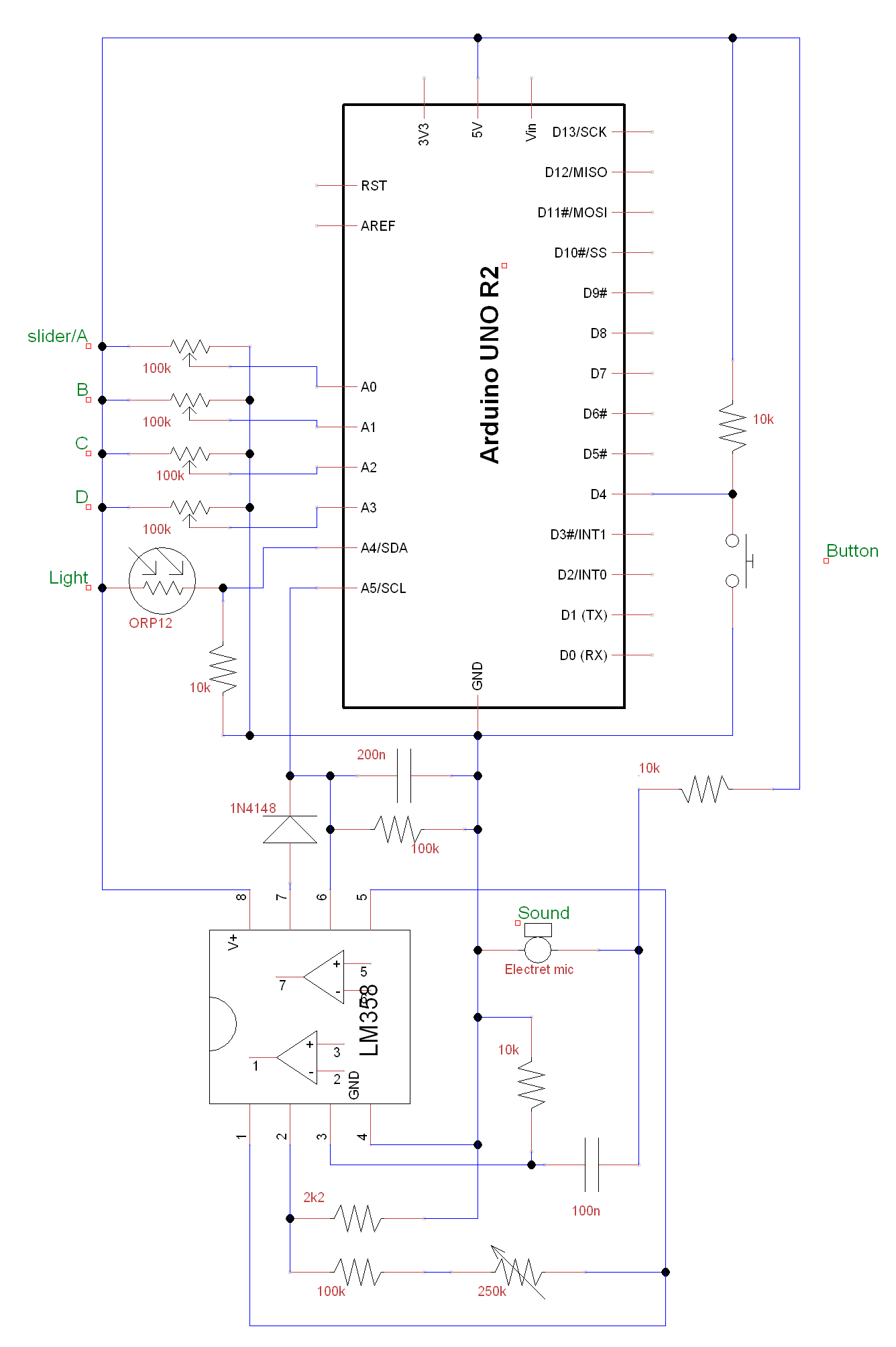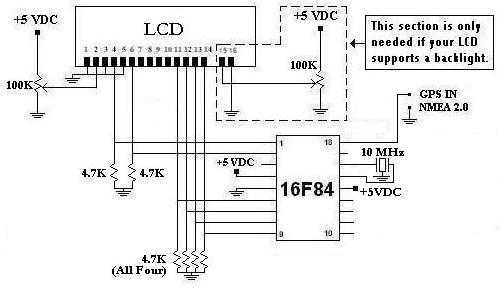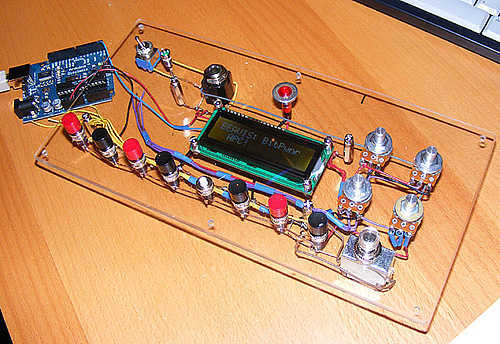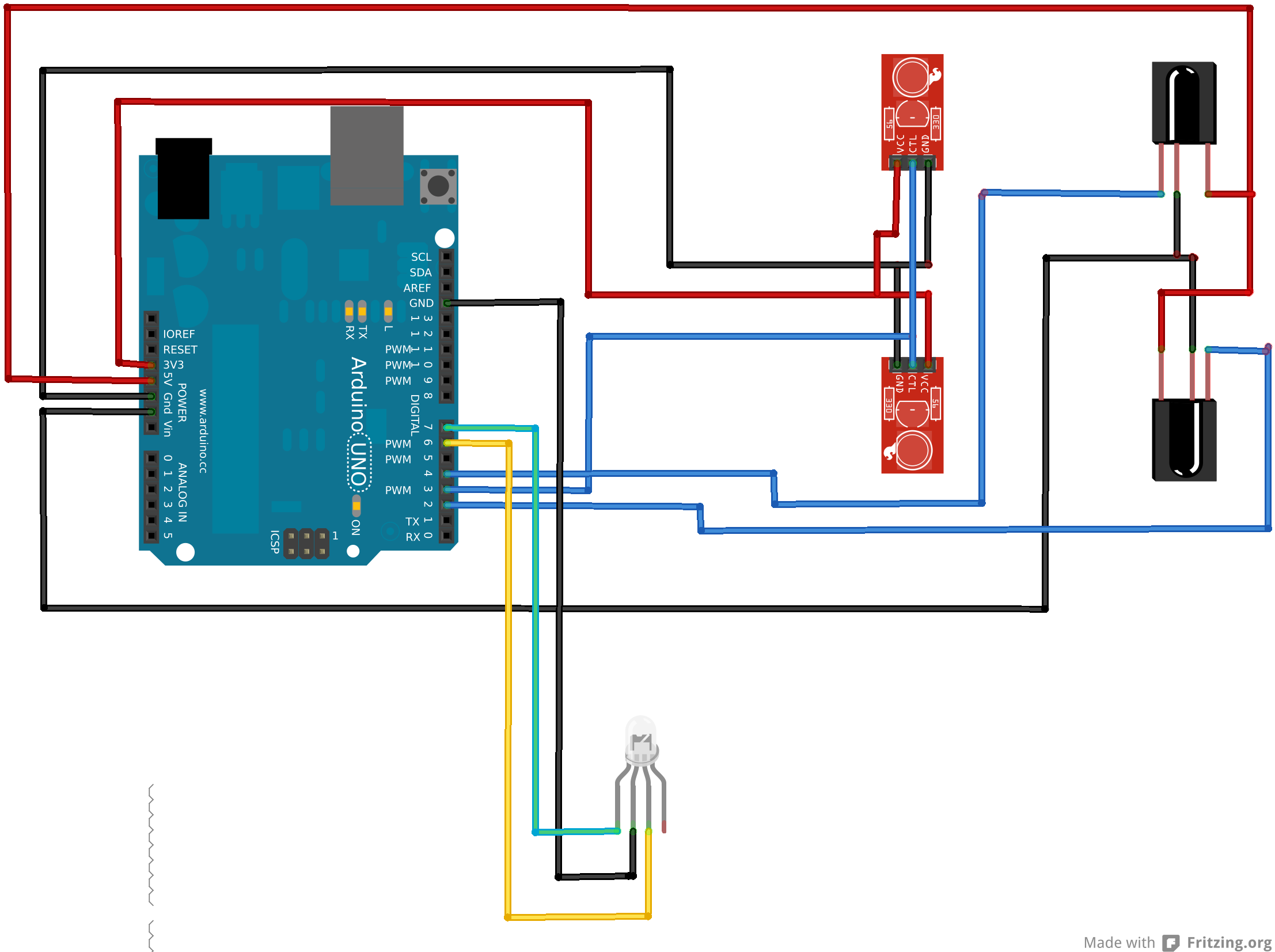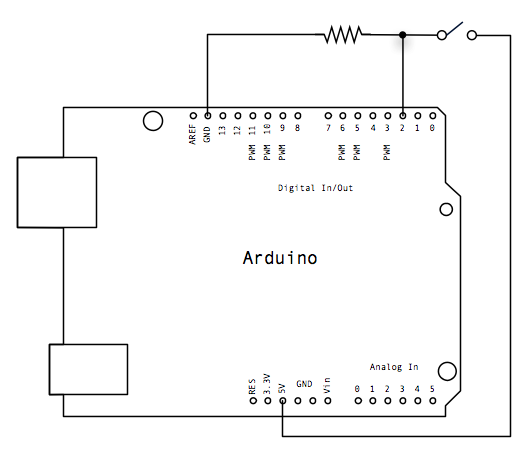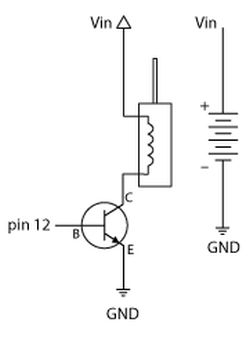
Arduino project
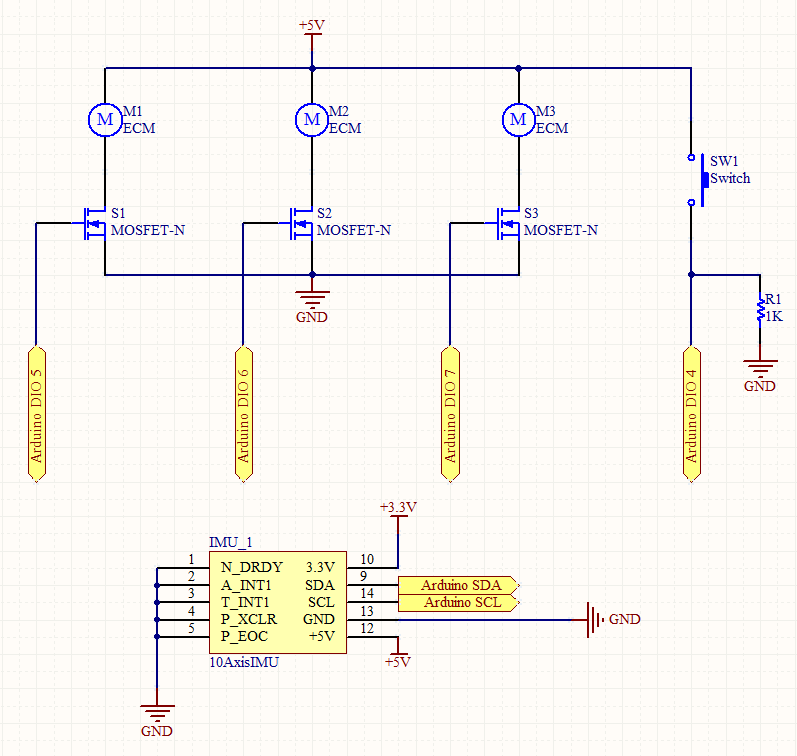
Many educational haptic feedback devices utilize kinesthetic force feedback systems like the Novint Falcon and the Phantom Omni. While these devices are relatively affordable compared to higher-end haptic systems, they remain costly for educational purposes. Consequently, a team has decided to develop an economical vibrotactile haptic device intended for enhancing teaching across various disciplines through haptic feedback. The device must be versatile enough to be applicable in diverse educational contexts. The motivation for employing vibrotactile feedback stems from its successful implementation in real-world applications such as medical catheter teleoperation, gaming controllers, and mobile phones. Additionally, vibrotactile feedback devices are generally simpler and less expensive than kinesthetic feedback systems, making them suitable for educational use. Numerous haptic applications have been designed to teach scientific concepts, such as using the Phantom Omni with detailed molecular simulations to convey chemical bonding information and employing the Novint Falcon to allow users to feel atomic interactions. Haptic feedback has also been utilized to teach mathematical functions to visually impaired individuals by enabling them to perceive the curves and shapes of mathematical functions. Although many educational haptic applications rely on commercial products like the Novint Falcon and the Phantom Omni, their costs—around $300 for the Novint Falcon and $1000 for the Phantom Omni—pose a barrier for schools that require multiple devices. Vibrotactile haptic feedback has been employed in various industries, including pagers and cell phones for notifications, gaming for enhanced realism, and medical teleoperation systems to convey obstacle information. Despite these applications, vibrotactile haptic feedback devices are not widely used in education, highlighting the need for a cost-effective, generic vibrotactile feedback device for educational settings. The design aims to create a self-contained vibration feedback device that does not require external power or wiring, allowing for complete freedom of motion. To achieve this, the device will be battery-powered and utilize wireless communication with an external computer. The proposed design features a spherical haptic device with finger indentations, standardizing user handling while providing vibration feedback to individual fingers. By isolating the vibration motors from the haptic sphere structure, users will be able to distinguish vibrations from different motors more effectively.
The proposed vibrotactile haptic feedback device is designed with several key components to facilitate its functionality and usability in educational environments. The device will incorporate a microcontroller that manages the vibration motors and wireless communication protocols, ensuring efficient operation and responsiveness to user input. The choice of battery type will be critical, with a focus on rechargeable lithium-ion batteries to provide a balance between weight, size, and battery life.
The spherical shape of the device will be manufactured using lightweight materials, such as ABS plastic or silicone, which will also enhance user comfort. The finger indentations will be ergonomically designed to accommodate various hand sizes, promoting ease of use for a wider audience. Each indentation will house a small vibration motor capable of generating varying frequencies and intensities of vibration to convey different types of haptic feedback.
Wireless communication will be established using Bluetooth or Wi-Fi modules, allowing seamless interaction with educational software running on external computers or tablets. This interaction will enable educators to customize haptic feedback experiences based on the curriculum and specific learning objectives, enhancing engagement and understanding of complex concepts.
The software interface will be developed to allow teachers to create and modify haptic feedback scenarios easily. It will include pre-defined templates for scientific and mathematical applications, as well as tools for educators to design their own haptic experiences. This adaptability will ensure that the device can be used across various subjects and educational levels.
In summary, the development of an affordable, versatile vibrotactile haptic feedback device aims to bridge the gap in educational haptic technology. By combining user-centered design, efficient wireless communication, and a robust software platform, this device has the potential to enhance learning experiences across multiple disciplines, making haptic technology accessible to a broader range of educational institutions.Many educational haptic feedback devices use kinesthetic force feedback devices such as the Novint Falcon and the Phantom Omni. Although these devices are relatively cheap compared to other high end haptic feedback devices, they are still expensive for educational purposes.
Our team has therefore decided to develop an affordable vibrotactile hapti c device that can be used as an education tool for augmenting teaching of various disciplines through the use of haptics. The device must be generic enough such that it can be used in many different educational situations. Our team`s intention to use vibrotactile feedback is motivated by the fact that vibrotactile feedback devices had been used in real-world applications such as medical catheter teleoperator, gaming controller, and mobile phones with considerable success.
In addition, vibrotactile feedback devices are generally less complex and cheaper compared to kinesthetic feedback devices, which makes it suitable for use in the education field. Many haptics applications have been designed for teaching scientific concepts in the educational field.
For example, [1] and [2] use the Phantom Omni haptic device together with detailed molecular simulation in order to convey chemical bonding information to the user. Similarly, [3] has used the Novint Falcon to allow user to the feel the molecules and their atomic interaction forces.
[4] has used haptics to teach mathematical functions to people with vision disabilities, by allowing them to feel the curve and shape of the mathematical functions. Many of the above educational haptics applications rely on commercial products such as the Novint Falcon and the Phantom Omni, Though this product are cheap compared to other high end haptic devices, they still cost from $300 for the Novint Falcon and $1000 for the Phantom Omni.
Given that schools typically requires tens or more haptic devices, such high cost will prevent them from investing in using haptics as a tool for their education work. Vibrotactile haptic feedback devices has been used in many industries with varying degrees of success.
Vibration feedback has long been used in pagers and cell phones to inform user of impending phone calls, messages, or emails. In the gaming sector, vibration feedback has been used to add realism to the gaming experience [5], in which gamers feel vibrations whenever they are being attacked or when they bumped into a wall.
Recently, vibration feedback had been used in medical catheter teleoperation systems to convey obstacle information to the surgeon. Given such rich uses of vibrotactile feedback in many other fields, it is a wonder why vibrotactile haptic feedback devices has not been more pervasive in the education field.
Our literature study informs us that there are very few devices that uses vibration feedback for use in education or teaching. This therefore motivates us to come up with a cheap yet generic vibrotactile feedback device for use in educational settings.
For our overall design, our team has decided to come up with a vibration feedback device that is self contained, i. e. , no external power input or wiring cable needs to be attached to the device. This is to allow complete freedom of motion when using our device. In order to realize this objective, the device will be battery powered, and that wireless communication will be used to communicate between the device and an external computer.
Our team has decided to come up with a spherical shaped haptic device with finger indentations. This design allows us to standardize the manner in which user will handle the haptic device. In addition, vibration feedback can be provided to the user`s individual fingers through the finger indentations. By placing the vibration feedback under the user`s finger and isolating the vibration of the motor from the haptic sphere structure, user will be able to better discriminate the vibration between the different motors,
🔗 External reference
The proposed vibrotactile haptic feedback device is designed with several key components to facilitate its functionality and usability in educational environments. The device will incorporate a microcontroller that manages the vibration motors and wireless communication protocols, ensuring efficient operation and responsiveness to user input. The choice of battery type will be critical, with a focus on rechargeable lithium-ion batteries to provide a balance between weight, size, and battery life.
The spherical shape of the device will be manufactured using lightweight materials, such as ABS plastic or silicone, which will also enhance user comfort. The finger indentations will be ergonomically designed to accommodate various hand sizes, promoting ease of use for a wider audience. Each indentation will house a small vibration motor capable of generating varying frequencies and intensities of vibration to convey different types of haptic feedback.
Wireless communication will be established using Bluetooth or Wi-Fi modules, allowing seamless interaction with educational software running on external computers or tablets. This interaction will enable educators to customize haptic feedback experiences based on the curriculum and specific learning objectives, enhancing engagement and understanding of complex concepts.
The software interface will be developed to allow teachers to create and modify haptic feedback scenarios easily. It will include pre-defined templates for scientific and mathematical applications, as well as tools for educators to design their own haptic experiences. This adaptability will ensure that the device can be used across various subjects and educational levels.
In summary, the development of an affordable, versatile vibrotactile haptic feedback device aims to bridge the gap in educational haptic technology. By combining user-centered design, efficient wireless communication, and a robust software platform, this device has the potential to enhance learning experiences across multiple disciplines, making haptic technology accessible to a broader range of educational institutions.Many educational haptic feedback devices use kinesthetic force feedback devices such as the Novint Falcon and the Phantom Omni. Although these devices are relatively cheap compared to other high end haptic feedback devices, they are still expensive for educational purposes.
Our team has therefore decided to develop an affordable vibrotactile hapti c device that can be used as an education tool for augmenting teaching of various disciplines through the use of haptics. The device must be generic enough such that it can be used in many different educational situations. Our team`s intention to use vibrotactile feedback is motivated by the fact that vibrotactile feedback devices had been used in real-world applications such as medical catheter teleoperator, gaming controller, and mobile phones with considerable success.
In addition, vibrotactile feedback devices are generally less complex and cheaper compared to kinesthetic feedback devices, which makes it suitable for use in the education field. Many haptics applications have been designed for teaching scientific concepts in the educational field.
For example, [1] and [2] use the Phantom Omni haptic device together with detailed molecular simulation in order to convey chemical bonding information to the user. Similarly, [3] has used the Novint Falcon to allow user to the feel the molecules and their atomic interaction forces.
[4] has used haptics to teach mathematical functions to people with vision disabilities, by allowing them to feel the curve and shape of the mathematical functions. Many of the above educational haptics applications rely on commercial products such as the Novint Falcon and the Phantom Omni, Though this product are cheap compared to other high end haptic devices, they still cost from $300 for the Novint Falcon and $1000 for the Phantom Omni.
Given that schools typically requires tens or more haptic devices, such high cost will prevent them from investing in using haptics as a tool for their education work. Vibrotactile haptic feedback devices has been used in many industries with varying degrees of success.
Vibration feedback has long been used in pagers and cell phones to inform user of impending phone calls, messages, or emails. In the gaming sector, vibration feedback has been used to add realism to the gaming experience [5], in which gamers feel vibrations whenever they are being attacked or when they bumped into a wall.
Recently, vibration feedback had been used in medical catheter teleoperation systems to convey obstacle information to the surgeon. Given such rich uses of vibrotactile feedback in many other fields, it is a wonder why vibrotactile haptic feedback devices has not been more pervasive in the education field.
Our literature study informs us that there are very few devices that uses vibration feedback for use in education or teaching. This therefore motivates us to come up with a cheap yet generic vibrotactile feedback device for use in educational settings.
For our overall design, our team has decided to come up with a vibration feedback device that is self contained, i. e. , no external power input or wiring cable needs to be attached to the device. This is to allow complete freedom of motion when using our device. In order to realize this objective, the device will be battery powered, and that wireless communication will be used to communicate between the device and an external computer.
Our team has decided to come up with a spherical shaped haptic device with finger indentations. This design allows us to standardize the manner in which user will handle the haptic device. In addition, vibration feedback can be provided to the user`s individual fingers through the finger indentations. By placing the vibration feedback under the user`s finger and isolating the vibration of the motor from the haptic sphere structure, user will be able to better discriminate the vibration between the different motors,
🔗 External reference
Warning: include(partials/cookie-banner.php): Failed to open stream: Permission denied in /var/www/html/nextgr/view-circuit.php on line 713
Warning: include(): Failed opening 'partials/cookie-banner.php' for inclusion (include_path='.:/usr/share/php') in /var/www/html/nextgr/view-circuit.php on line 713
